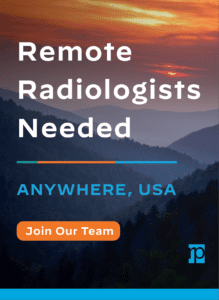Radiology Partners is proud of the unique ways our radiologists go the extra mile to provide mammography and other necessary radiology services. Our local practices meet the needs of communities they serve however they are able – even if it requires a ferry or a small plane, like in Alaska.
Alaska Radiology Associates, an RP-affiliated practice based in Anchorage, is comprised of nearly 20 fellowship-trained radiologists who partner with both urban and rural healthcare facilities to provide subspecialty and interventional radiology services across the entire state.
“We provide screening and diagnostic services to a very large geographical area with a relatively small population,” said Dr. Heather Tauschek, a full-spectrum general diagnostic radiologist fellowship trained in breast imaging.
Dr. Tauschek was born and raised in Alaska, and after completing her training, she wanted to serve patients across her vast home state and offer radiology services to hard-to-reach areas of the region. Today, she shares duties as director of breast imaging services for the practice, where she and her co-director Dr. Brittany O’Steen are lead interpreting physicians for mammography for multiple sites, including three of the four breast imaging centers of excellence in Alaska and the mammography services at critical access hospitals across the state.
Many communities in Alaska are only accessible by boat or small airplane, while trips to larger towns with access to healthcare can take upwards of 10 hours or more, often requiring overnight stays. All of this creates a barrier for rural populations to access routine healthcare services. So, with few radiologists and technologists covering such a large region with limited road systems, Dr. Tauschek’s team takes unique approaches to meet patients where they are.
One of the ways her team serves patients is by mobile mammography van. “We have technologists who navigate the big mobile mammography van onto the ferries, also known as the ‘Alaska Marine Highway,’” she explained. The technologist team drives the van full of sensitive equipment and a generator to some of the more remote areas to provide screenings. After, they must locate a place where they can access a secured internet connection to successfully send images back to the practice for interpretation.
While the van is helpful in reaching some patients in Alaska’s diverse landscape, many clinical sites are off the path of the limited Alaskan road system. Dr. Tauschek and her radiologist colleagues rotate in person through some of these sites, like Kodiak Island, and reach other off-grid sites by providing teleradiology services to critical access hospitals serving these remote regions, often where indigenous communities reside. “The Alaska Native Tribal Health Consortium is a state-wide healthcare system that provides care for the indigenous population, which is about 15-20% of Alaska,” Dr. Tauschek said. “Our hospitals serving these populations are critical access hospitals often linked to the Tribal Health Consortium.”
These small critical access hospitals serve a valuable purpose, allowing patients to be stabilized and moved to a higher level of care in a bigger area with more resources, if needed, such as Anchorage. For radiology care, Dr. Tauschek and her colleagues are the radiologists on whom these small critical access hospitals rely, providing needed imaging services and performing routine screenings, such as mammograms. In fact, every critical access hospital they serve has a screening mammography program.
Patients travel from their small villages surrounding the critical access hospitals to access care, often traveling by small plane, boat, ATV or even snow machine. “We do see abnormal amounts of late-stage diagnoses because it’s so difficult to travel to receive care,” Dr. Tauschek said. Outside of travel limitations, a large fishing and marine-based trading industry mean some patients spend months at a time at sea without coming home for regular medical care. Many advanced-stage illnesses present when patients walk off the boat. “Also, for many months throughout the COVID-19 pandemic, many of the areas were shut down and there were a lot of regulations to navigate,” she recalled. “Our patients couldn’t get screenings for a long time.”
Dr. Tauschek visits many of the remote sites in person throughout the year, and in between site visits, she and her colleagues rely on teleradiology by partnering with technologists. “Often, we only have a few technologists at a site, and they are serving multiple roles,” Dr. Tauschek explained. “One tech might do CT, ultrasound and MRI, and the fact that they can perform those tasks across all of those modalities in a tiny town is pretty amazing.”
Often, the practice faces challenges adding to their team, as they dispel misconceptions about practicing in Alaska. First, while there are many remote areas in the state, Alaska remains relatively easy to travel to and from the rest of the world. Plus, the views help too. “It’s just jaw-droppingly beautiful,” she said. “It’s beautiful on a scale that you really can’t explain to people.”
“Also, there is a misconception that healthcare and imaging services are somehow below par because we’re providing rural services, and I always dispel that,” she said. While some of the rural facilities lack the newest technology and resources, others have excellent equipment. “That’s because of the level of funding they’ve been able to access through the tribal systems or larger community support. We have surprisingly good equipment in many of the locations.”
Another challenge is the small number of radiologists for such a large area, which requires their radiologists to read multiple modalities. Dr. Tauschek estimates she reads approximately 60% breast imaging and 40% general diagnostic imaging. “It requires all of us to be flexible.”
The other requirement? “Radiologists and technologists need an adventurous spirit here.”
Despite the challenges, her team is committed to prioritizing and maintaining standards of excellence. “A lot of people have the idea that because we’re remote or rural, we don’t provide high-quality care. We know we provide excellent care, and we’re very proud of that.”
Radiology Partners is a leading physician-led and physician-owned radiology practice in the U.S. For the latest news from RP, follow us on Twitter, LinkedIn, Instagram, YouTube and the RP blog. References to Radiology Partners, RadPartners and RP include its managed and owned medical practices that provide radiology services to patients throughout the United States.






